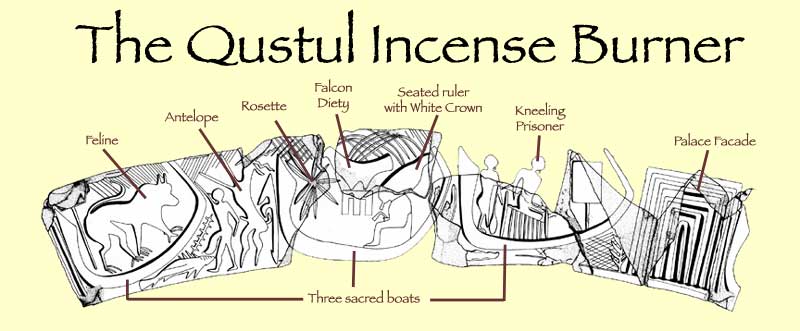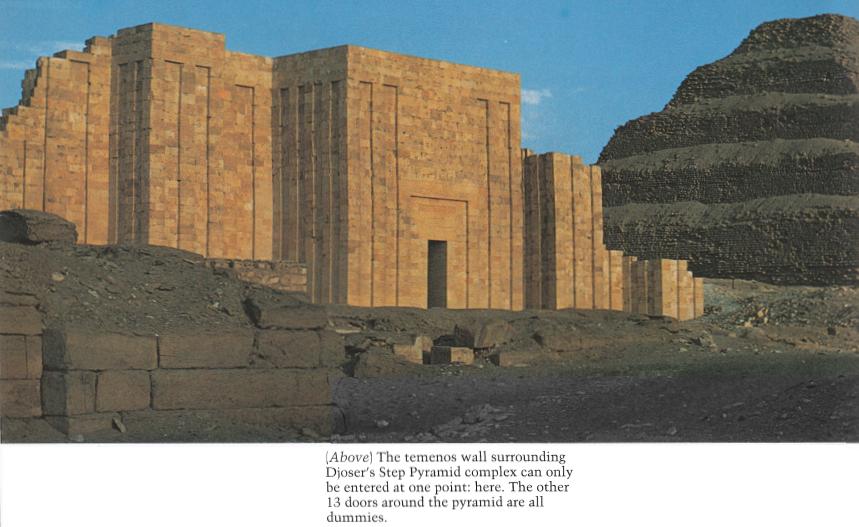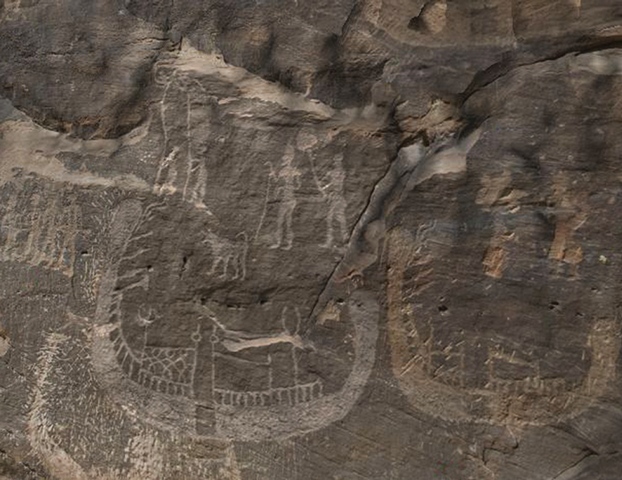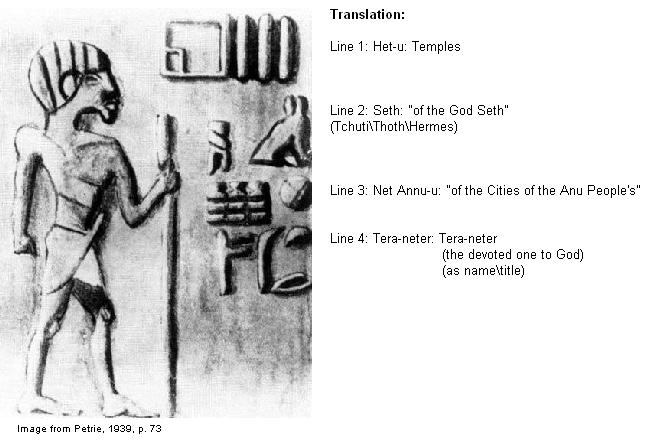It looks like you're using an Ad Blocker.
Please white-list or disable AboveTopSecret.com in your ad-blocking tool.
Thank you.
Some features of ATS will be disabled while you continue to use an ad-blocker.
share:
Originally posted by LUXUS
reply to post by braydenf
You can get a translation of the edfu text for example "the mythical origin of the Egyptian Temple" by E.A.E. Reymond.
One of the most common depictions of Osiris is him with the other neteru arriving in Egypt in his solar boat.
I have read the translation of the edfu text and it talks about a battle in the land of conflict (hence the name), the destruction of the temple of the hawk, and subsequently arriving in Egypt with the other neteru.
Herodotus wrote that Sais is where the grave of Osiris is which is in north Egypt at the mouth of the Nile delta.
The oldest architecture is in the north not the south and definitely not in kush
The Greeks, such as Herodotus, Plato and Diodorus Siculus, identified her with Athena and hence postulated a primordial link to Athens. Diodorus recounts that Athena built Sais before the deluge that supposedly destroyed Athens and Atlantis. While all Greek cities were destroyed during that cataclysm, the Egyptian cities including Sais survived.
en.wikipedia.org...


This is a piece of the Qustol incense burner from Nubia's A group culture the first state on the Nile,notice the Palace facade with Djoser's Temple,In the same region we have even more clues to what was to become the first kings.


The oldest known representations of a Pharaoh dating back as far as 3200BC have been found carved on rocks near the Nile River in southern Egypt, a new study claims.
Researchers say the engravings on rock faces in the desert four miles north of the Aswan Dam are the earliest found indication of royal power in the country.
The images of a Pharaoh riding boats with attendant prisoners and animals offer a window on Dynasty 0, they say, and show the moment pre-Dynastic Egypt was first captured by the rule of a single monarch.
Read more: www.dailymail.co.uk...
Follow us: @MailOnline on Twitter | DailyMail on Facebook
Again Nubia was the gold producing region of Egypt it was there the first nome or state developed it covered both Southern Egypt and Northern Sudan,it sent it's kings down river and formed other colonies till they reached the Med. they were bascially indepentent until a Southern King crush his rival Ta-Seti aka Land or the Bow and later Kush,went on to unite the all Egypt.
From the Kememu
Anu the city of Heliopolis (Coptic; On)
Anu Meh Anu of the north (Heliopolis)
Anu Shemo Anu of the south (Hermonthis/Ermant)
Anu Monti Anu of Hermonthis
Anu Tem the Anu of Tem (Hermonthis)
Anu Re the Anu of Re
Afdu Ikhu the Four Ancestors (of the Anu)
Ugrit Goddess of the Duat of Anu
Djandjané Anu the Anu Court of Judges: Tem; Shu; Tefnut; Osiris; Thoth
Anu n Ptoh the Anu of Ptah (Denderah)
Anu n Nut the Anu of Nut (Denderah)

The Aunu People. Besides these types, belonging to the north and east, There is the aboriginal race of the Anu, or Aunu, people (written with three pillars), who became a part of the historic inhabitants. The subject ramifies too doubtfully if we include all single-pillar names, but looking for the Aunu, written with the three pillars, we find that they occupied Southern Egypt and Nubia, and the name is also applied in Sinai and Libya.
As to the Southern Egyptians, we have the most essential document, a portrait of a chief, Tera-neter, roughly modeled in relief in green glazed faience, found in the early temple at Abydos. Preceding his name, his address is given on this earliest of visiting cards, "Palace of the Aunu in Hermen city, Tera-neter." Hemen was the name of the god of Tuphium (Lanz., Dict, 544), 13 miles south of Luqsor. Erment, opposite to it, was the place of Aunu of the south, Aunu Menti. The next place in the south is Aunti (Gebeleyn), and beyond that Aunyt-seni (Esneh)
Denderah
Judging by the sheer number of given titles, the most venerated city of Kemet was not Thebes, but Denderah. After all, this was the city where the Parents of the Kemetian nation (Isis and Osiris) were born. (It is also in the same neighborhood as Naqada). Here are some of the titles of this city:
"The birthplace of Isis"
"The Throne of the Queen"
"The perfect throne in the Holy of Holies"
"The place of joy"
"The thrones of Horus"
"The holy temple of Horus"
"The throne of eternity"
"The throne of the drink"
"The birthplace of Nut"
"The Golden House"
"The Sanctuary of Osiris"
"The Sanctuary of Re"
"The city of the knowing of Isis"
"The temple of life"
"The temple of Hathor"
"The eternal house"
"The exalted temple"
"The holy temple of Horus of the Two-Lands"
"The house of knowledge" (per Rekhit)
The Sudanese Country of Bukem (Buqem)
reply to post by Spider879
I dont want to get into this because its not what this thread is about but if you read the article the image shows
"the 'Following of Horus', a biennial tax-collection tour made by the royal court to stamp its authority on the country"
Its showing the pharaoh traveling south down the Nile to collect taxes in Nubia not the pharaoh traveling north bringing Egyptian civilization to lower Egypt as your trying to suggest.
news.discovery.com...
I dont want to get into this because its not what this thread is about but if you read the article the image shows
"the 'Following of Horus', a biennial tax-collection tour made by the royal court to stamp its authority on the country"
Its showing the pharaoh traveling south down the Nile to collect taxes in Nubia not the pharaoh traveling north bringing Egyptian civilization to lower Egypt as your trying to suggest.
"These tableaux show not only the earliest datable image of a king in one of the canonical crowns of pharaonic Egypt, but also the presence of the Following of Horus in the border area between Egypt and Nubia at the dawn of the First Dynasty," Darnell said. "The carvings may therefore be the earliest record of tax collection we have from Egypt, and the first expression of royal economic control over Egypt and most probably also Nubia," the researchers concluded.
news.discovery.com...
reply to post by Harte
Hello Harte I thought the greeks where called by the vedic Pullindas?
The Yavanas are the Greeks, considered in the Vedas to be particularly clever peoples:
Hello Harte I thought the greeks where called by the vedic Pullindas?
edit on 20/02/2009 by Karmayogi11 because: (no reason given)
Originally posted by LUXUS
Originally posted by Harte
No wonder the Greeks beat Atlantis. After all, Atlantis didn't have an air force.
Isn't that what you're saying?
No its not what I'm saying, what i'm saying is that they must have had equal footing technologically with Atlantis so was able to stop them in their tracks.
According to the latter, the war between the Titans and Olympians raged on for ten years in a sort of stalemate, until Zeus "no longer restrained his soul, but straightway his mind was filled with fury and he showed forth all his might." His bolts "flew near at hand" with thunder and with lightning, while in his hands he was "rolling a holy flame." It crashed as it "burned the life-giving earth," and the "infinite wood cried aloud with fire." The oceans "seethed and boiled" as volcanoes (Cottus, Briareus and Gyes) hurled rocks by the hundreds. Once defeated, the warlike Titans are bound and imprisoned forever in Tartarus, a mythological prison far beneath the "waves of the restless ocean" in the far West. The hint is given that "divine weapons"—given to Zeus by Kyklopes and Hekatoncheires—turned the tide against the Titans.
www.atlantisquest.com...
So now Zeus was just a Greek man?
Sorry, Zeus was a god. Yet the Vedas credit the Greek humans with the invention of the vimana.
It simply doesn't work.
Harte
edit on 2/13/2013 by Harte because: (no reason given)
Originally posted by LUXUS
reply to post by FatherLukeDuke
Yeah, explain vitrified rock forts and pottery? People have tried to recreate it with wood fires, so far everyone has failed to replicate it.
edit on 12-2-2013 by LUXUS because: (no reason given)
In fact, the effect has been duplicated on small piles of certain types of stone using wood fires.
Harte
Originally posted by Karmayogi11
reply to post by Harte
The Yavanas are the Greeks, considered in the Vedas to be particularly clever peoples:
Hello Harte I thought the greeks where called by the vedic Pullindas?
The concept of "Greek" as a singular culture didn't exist in ancient times, as they were all city-states.
The term Luxus used - Yarvanas - indicates the Ionian peoples. You are aware that Ionians lived in present-day Turkey, right?
Given that the peoples that lived in what we today call "Greece" had different names for their individual groups and (usually) had no affiliation with other groups (except to kill each other - think Athens and Sparta,) it would be surprising indeed if Vedic cultures referred to the entire set of all these peoples with the same term, would it not?
Harte
edit on 2/13/2013 by Harte because: (no reason given)
reply to post by Harte
No Zeus is known as Indra in vedic culture but you would need to know about the gods to know that, complete with thunderbolt.
No Zeus is known as Indra in vedic culture but you would need to know about the gods to know that, complete with thunderbolt.
reply to post by Harte
Nope it has not, a while back a guy decided to burn I think 5 lorry loads of timber which burnt for two days continuously at the end of all that there was supposedly one buckled rock. They concluded it would take all the trees in Scotland to vitrify a whole fort...think you can count that as a fail not a success.
Nope it has not, a while back a guy decided to burn I think 5 lorry loads of timber which burnt for two days continuously at the end of all that there was supposedly one buckled rock. They concluded it would take all the trees in Scotland to vitrify a whole fort...think you can count that as a fail not a success.
Originally posted by LUXUS
Yeah, explain vitrified rock forts and pottery?
I'm not sure what vitrified forts have to do with Mohenjo Daro, though there have been some success at reproducing the effect.
How do I explain vitrified pottery? You make it in a kiln. Just like they did at Mohenjo Daro.
Originally posted by LUXUS
reply to post by Spider879
I dont want to get into this because its not what this thread is about but if you read the article the image shows
"the 'Following of Horus', a biennial tax-collection tour made by the royal court to stamp its authority on the country"
Its showing the pharaoh traveling south down the Nile to collect taxes in Nubia not the pharaoh traveling north bringing Egyptian civilization to lower Egypt as your trying to suggest.
"These tableaux show not only the earliest datable image of a king in one of the canonical crowns of pharaonic Egypt, but also the presence of the Following of Horus in the border area between Egypt and Nubia at the dawn of the First Dynasty," Darnell said. "The carvings may therefore be the earliest record of tax collection we have from Egypt, and the first expression of royal economic control over Egypt and most probably also Nubia," the researchers concluded.
news.discovery.com...
Okay I will shelve it for another time as it can take away from the thread,but just so you know I am not totally against some areas of the ancient alien theory but I do think we short change ourselves by thinking everything is owed to E.Ts and among the most mis-undertood geographical area of research and studies is the Sahara,Nile valley and Great Lakes complex but that's for another time.
Originally posted by LUXUS
They concluded it would take all the trees in Scotland to vitrify a whole fort...think you can count that as a fail not a success.
All the trees in Scotland? Nonsense. It takes temperatures of 1100c to vitrify rock, and blacksmith's furnaces would reach 1300c, without using all the trees.
The mystery is what technique could have vitrified walls in situ.
There's a good summary of the evidence here
The most famous experiment, widely trumpeted in virtually all writings about the vitrified forts, was performed in 1934 and repeated in 1937 by Wallace Thorneycroft and Vere Gordon Childe who built a fire against an experimental stone wall, built to the observed specifications. As described in the 1966-67 edition of The Proceedings of the Society of Antiquaries of Scotland:
The experimental wall was 6 ft. wide and 6 ft. high, with horizontal timbers interlaced with stone slabs. After ignition through brushwood fires around the wall face, the wall began to burn and after three hours it collapsed. The core of basalt rubble became red hot, probably reaching 800 to 1200°C, and after excavation the bottom part of the rubble was found to be vitrified, with rock droplets and casts of timber preserved. The experiment proved that a timber-laced wall of this character could become vitrified through fire, but the explanation of the reasons for such widespread treatment of these Iron Age forts remains uncertain.
and
Keep in mind also that Thorneycroft and Childe were archaeologists with minimal stone melting skills, while the men who vitrified the forts two and a half millennia before them were expert professionals whose knowledge was based on centuries of experience.
What are you suggesting anyway? That a bunch of iron age Scottish warlords had a nuclear war that left all the forts standing, but fused the rocks together? Really?
Is this what your calling a success? The guy in the video is clearly embarrassed that his experiment has been a total failure in front of the
television crew so he grabs a rock and claims it has buckled hmmm one tiny rock after all that wood and liquid fuel.
Saying this was a success is like saying that pathetic pyramid replica they built on the Giza plateau with piddly blocks was a success.
Or saying that copper sediment saw which took half a day to put a scratch in a granite block
Or the attempt to recreate the transport of two stone pillars to show how the ancients built stone henge, as I recall one fell in the river and they just gave up with the second.
Saying this was a success is like saying that pathetic pyramid replica they built on the Giza plateau with piddly blocks was a success.
Or saying that copper sediment saw which took half a day to put a scratch in a granite block
Or the attempt to recreate the transport of two stone pillars to show how the ancients built stone henge, as I recall one fell in the river and they just gave up with the second.
reply to post by LUXUS
That experiment was for a TV show from 1980, my reference was to an experiment carried out in 1937 and then again in 1977 - which had some partial success - enough for proof of concept. How it was done exactly is a mystery, but a mystery does not equal iron age nuclear war (which leaves all the buildings standing while melting them). There are lots of things we can't reproduce using the same tech now, as the skills and knowledge have been lost. Nobody is going to spend their whole life practising fort vitrification, as it's kinda pointless.
Luxus, what is your point exactly? You seem determined to take your own thread off-topic.
We were debating your claims of ancient Indian nuclear war, specifically Mohenjo Daro. When challenged for scientific evidence you start bringing up all sorts of stuff about supernova effects on North America and Scottish Hill forts which, while interesting, is irrelevant.
It seems you have a pre-determined narrative to spin, and when pesky people like me ask for evidence, you just wave your hands around.
That experiment was for a TV show from 1980, my reference was to an experiment carried out in 1937 and then again in 1977 - which had some partial success - enough for proof of concept. How it was done exactly is a mystery, but a mystery does not equal iron age nuclear war (which leaves all the buildings standing while melting them). There are lots of things we can't reproduce using the same tech now, as the skills and knowledge have been lost. Nobody is going to spend their whole life practising fort vitrification, as it's kinda pointless.
Luxus, what is your point exactly? You seem determined to take your own thread off-topic.
We were debating your claims of ancient Indian nuclear war, specifically Mohenjo Daro. When challenged for scientific evidence you start bringing up all sorts of stuff about supernova effects on North America and Scottish Hill forts which, while interesting, is irrelevant.
It seems you have a pre-determined narrative to spin, and when pesky people like me ask for evidence, you just wave your hands around.
edit on 13/2/13 by FatherLukeDuke because: (no reason given)
These flying vimana ships reminded me of the floating island described in Gulliver’s Travels by Jonathan Swift. The flying island in the story is
mentioned as being 4.5 miles in diameter and had an adamantine base. It moved around using magnetic levitation.

What makes this detail very interesting in regards to this thread is that Jonathan Swift correctly identified, in his novel, the number and orbits (not exact but pretty close) of the two small moons of Mars 150 years before they were discovered.
Phobos’ orbital period is actually 7.6 hours, Swift predicted 10 hours.
Deimos’ orbital period is actually 30.2 hours, Swift predicted 21.5 hours.
Gulliver’s Travels - 1726
Astronomical observation – 1877
Moons of Mars
This is the passage from the story that identifies the two small moons of Mars.
Laputa
I created a thread about this coincidence back in 2011. Check it out if you want.
The Martian moons Phobos and Deimos described 150 years before their discovery
Here’s the fun part. Jonathan Swift was born in Ireland which is where we get the legends of the Tuatha De Dannann people who are also associated in this thread as the danava of India. Swift may have read an ancient Celtic text which inspired him to describe the floating island and the moons of Mars.
Jonathan Swift
Thanks for sharing this information. It explains the mystery of why Swift knew such detailed information before its time.

What makes this detail very interesting in regards to this thread is that Jonathan Swift correctly identified, in his novel, the number and orbits (not exact but pretty close) of the two small moons of Mars 150 years before they were discovered.
Phobos’ orbital period is actually 7.6 hours, Swift predicted 10 hours.
Deimos’ orbital period is actually 30.2 hours, Swift predicted 21.5 hours.
Gulliver’s Travels - 1726
Astronomical observation – 1877
Moons of Mars
This is the passage from the story that identifies the two small moons of Mars.
www.unmuseum.org...
They [the Laputians] have likewise discovered two lesser stars, or satellites, which revolve about Mars, whereof the innermost is distant from the center of the primary planet exactly three of its diameters, and the outermost five; the former revolves in the space of ten hours, and the latter in twenty-one and a half; so that the squares of their periodical times are very near the same proportion with the cubes of their distance from the center of Mars, which evidently shows them to be governed by the same law of gravitation that influences the other heavenly bodies.-Gulliver’s Travels- Jonathan Swift – 1726
Laputa
I created a thread about this coincidence back in 2011. Check it out if you want.
The Martian moons Phobos and Deimos described 150 years before their discovery
Here’s the fun part. Jonathan Swift was born in Ireland which is where we get the legends of the Tuatha De Dannann people who are also associated in this thread as the danava of India. Swift may have read an ancient Celtic text which inspired him to describe the floating island and the moons of Mars.
Jonathan Swift
Thanks for sharing this information. It explains the mystery of why Swift knew such detailed information before its time.
(Posted something already mentioned)
edit on 2/14/2013 by Harte because: (no reason given)
reply to post by FatherLukeDuke
Firstly it is not my claim that irradiated skeleton have been found in India or that parts of sites have been cornered off due to radiation levels. Secondly vitrified brick/rock has been found in India also. Thirdly why do you suppose anyone would actually want to vitrify a rock or brick building? Fourthly what your calling "partial success" Im calling a complete failure so no I don't agree with you that there has been partial success, vitrify a small stone building or even a section of a wall and then I will call it a success. As for what has melted rock got to do with a nuclear blast, think you should be able to figure that out yourself.
Firstly it is not my claim that irradiated skeleton have been found in India or that parts of sites have been cornered off due to radiation levels. Secondly vitrified brick/rock has been found in India also. Thirdly why do you suppose anyone would actually want to vitrify a rock or brick building? Fourthly what your calling "partial success" Im calling a complete failure so no I don't agree with you that there has been partial success, vitrify a small stone building or even a section of a wall and then I will call it a success. As for what has melted rock got to do with a nuclear blast, think you should be able to figure that out yourself.
Originally posted by LUXUS
reply to post by FatherLukeDuke
Firstly it is not my claim that irradiated skeleton have been found in India or that parts of sites have been cornered off due to radiation levels. Secondly vitrified brick/rock has been found in India also. Thirdly why do you suppose anyone would actually want to vitrify a rock or brick building? Fourthly what your calling "partial success" Im calling a complete failure so no I don't agree with you that there has been partial success, vitrify a small stone building or even a section of a wall and then I will call it a success.
First, the wall must be built well enough that it doesn't collapse, which was what occured in the mentioned experiment.
Secondly, the entire process only took a few hours (three, IIRC.) Given days to accomplish vitrification, the proof of concept shows that it can be done.
On the other hand, you have a real problem claiming nuclear blasts. After all, did they merely invent a fission bomb in order to vitrify some forts? Where is any evidence at all for any nuclear technology? You realize, I hope, that the vitrifications we're talking about here are not particularly ancient.
Harte
Originally posted by LUXUS
Firstly it is not my claim that irradiated skeleton have been found in India or that parts of sites have been cornered off due to radiation levels.
When did I say that was your claim?? You said:
Originally posted by LUXUS
Also I have seen graves like that and when they examined them they found them to be highly radioactive,
That is what I'm challenging, and you have nothing to support that statement.
Thirdly why do you suppose anyone would actually want to vitrify a rock or brick building?
I've no idea - it would be speculation, as they didn't write down their reasons. They probably thought it was cool. Why do you suppose that humans do a lot of the things we do? Why do we create works of art, or build cathedrals, or whatever.
Fourthly what your calling "partial success" Im calling a complete failure
You can call it whatever you like, but the fact remains that in only a few hours, with no knowledge of how the original stone smelters would have done it, they managed to vitrify some stone:
The experimental wall was 6 ft. wide and 6 ft. high, with horizontal timbers interlaced with stone slabs. After ignition through brushwood fires around the wall face, the wall began to burn and after three hours it collapsed. The core of basalt rubble became red hot, probably reaching 800 to 1200°C, and after excavation the bottom part of the rubble was found to be vitrified, with rock droplets and casts of timber preserved. The experiment proved that a timber-laced wall of this character could become vitrified through fire, but the explanation of the reasons for such widespread treatment of these Iron Age forts remains uncertain.
As for what has melted rock got to do with a nuclear blast, think you should be able to figure that out yourself.
You are very keen on answering questions that I haven't asked. Lets try again:
Are you suggesting that iron age Celtic warlords had a nuclear war in Scotland? If so, what kind of nuclear weapon did the use that would leave the entire hill fort standing but would vitrify the walls?
edit on 14/2/13 by FatherLukeDuke because: (no reason given)
new topics
-
Traveling the world with no passport
Social Issues and Civil Unrest: 2 hours ago -
Happy Thanksgiving to ATS
General Chit Chat: 6 hours ago
top topics
-
Mind Blowing Cave under someones land
Fragile Earth: 16 hours ago, 17 flags -
The Party of Peace - Trump Cabinet Picks Targeted with Death Threats
US Political Madness: 17 hours ago, 15 flags -
Simple Thanksgiving
Food and Cooking: 12 hours ago, 15 flags -
Trump Presidential Transition Team will not use GSA or Government entities to come to DC
US Political Madness: 16 hours ago, 14 flags -
Trump could make a peaceful American Revolution
US Political Madness: 15 hours ago, 14 flags -
Happy Thanksgiving to ATS
General Chit Chat: 6 hours ago, 6 flags -
Traveling the world with no passport
Social Issues and Civil Unrest: 2 hours ago, 5 flags
active topics
-
Simple Thanksgiving
Food and Cooking • 28 • : yeahright -
Petition Calling for General Election at 564,016 and rising Fast
Political Issues • 107 • : gortex -
Traveling the world with no passport
Social Issues and Civil Unrest • 2 • : AdultMaleHumanUK -
I thought Trump was the existential threat?
World War Three • 116 • : andy06shake -
Well, here we go red lines crossed Biden gives the go ahead to use long range missiles
World War Three • 402 • : andy06shake -
Mind Blowing Cave under someones land
Fragile Earth • 18 • : Flyingclaydisk -
D.B. Cooper mystery may be solved
General Conspiracies • 22 • : andy06shake -
Happy Thanksgiving to ATS
General Chit Chat • 4 • : VariedcodeSole -
Post A Funny (T&C Friendly) Pic Part IV: The LOL awakens!
General Chit Chat • 7840 • : GENERAL EYES -
Trump Presidential Transition Team will not use GSA or Government entities to come to DC
US Political Madness • 14 • : WeMustCare
